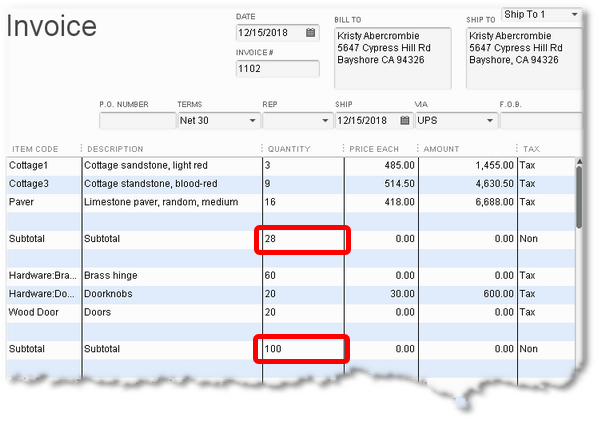This example demonstrates:
•How to set up a trigger Item in the QuickBooks Item list
•How to total a column
•How to subtotal a column
How to Total a Column
Totaling columns is a common need, and the most common use for Item-triggered formulas. Item-triggered formulas are those which FormCalc SST applies only when a specific Item name is encountered—the Item name you have entered on the Item-triggered formula's row in FormCalc SST.
| Items which "trigger" Item-triggered formulas are often referred to as trigger Items. |
Totaling a column with FormCalc SST involves (1) setting up a trigger Item in QuickBooks, (2) using that Item name on QuickBooks forms where you want the total to appear, and (3) associating the Item name with an Item-triggered formula row which calculates the total.
Setting up a trigger Item
Trigger Items are usually QuickBooks Items you have set up specifically for the purpose of triggering FormCalc SST calculations.
| This isn't always true. See Tips for Trigger Items in the Item-triggered formulas topic. |
For this example we will set up a Service-type Item named Total.
1.Open the Item list by choosing Lists > Item list from the QuickBooks main menu.
2.Choose New from the Item button's menu at the bottom of the Item list window.
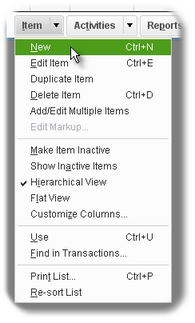
| The New Item window will open. |
3.Fill the New Item window's fields as shown here.
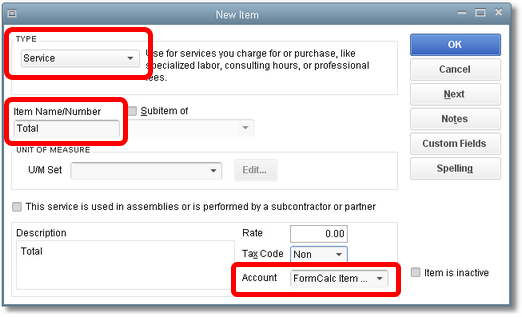
| Notes: |
•The Item name and Description can be anything you want.
•The Account this Item posts to is an equity-type account set up specifically for working with FormCalc SST trigger Items, called FormCalc Item Posting. We could have posted to an income or expense account, but using an equity account dedicated to this purpose makes spotting errors easier (unintentionally posting income or expense, etc.). For an explanation, see Tips for Trigger Items in the Item-triggered formulas topic.
Using the trigger Item on QuickBooks forms
The location of the Total Item will determine where FormCalc SST calculates a total. Generally you will want to enter it as the last line in the form's Detail section, like this:
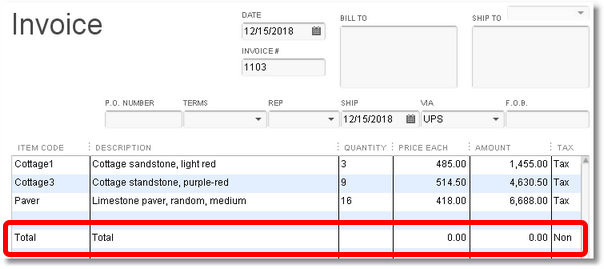
The total won't be calculated, of course, until FormCalc SST processes the form.
Setting up formulas in FormCalc SST
1.Take a snapshot of the QuickBooks form.
| Taking a snapshot of the form is always necessary before setting up formulas. Because taking snapshots is described in several earlier sections, the details won't be shown again here. |
2.Choose a column type for each column in the snapshot by right-clicking in each column on the Column types row, then selecting the column type from the pop-up menu, as shown here for the Amount column:
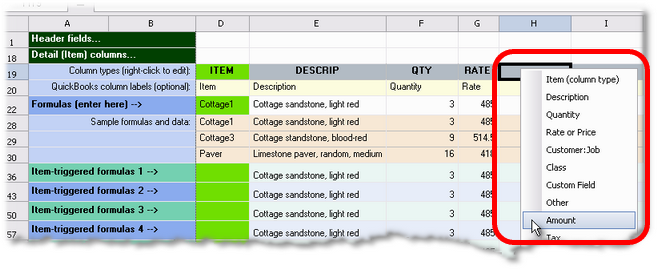
3.Enter a formula to total the desired column.
| The formula must be entered on one of the Item-triggered formulas rows—let's use the Item-triggered formulas 1 row. For this simple example our formula will total the Quantity column, but you can total any numeric column in the Detail section of a form. |
| Enter the following formula in the Quantity column on the Item-triggered formulas 1 row (cell F36 in this example): |
| =SUM(F1:F1) |
| "Wait a minute! This formula appears to sum cell F1. Is that really what will happen?" No. When entering formulas you can refer to the whole column of data without using exact cell coordinates. FormCalc SST will adjust your formula to the required coordinates immediately after you've entered it, as described below. (For details, see "Close enough" cell referencing in the Formulas and cell references topic.) |
| FormCalc SST will convert the formula to: |
| =SUM(F28:F30) |
| (Cell range references to the first and last row of the Sample formulas and data area—the rows with tan backgrounds in the screenshot above—tell FormCalc SST to reference "the whole column of data" when processing a QuickBooks form.) |
4.Enter the trigger Item's name (Total, in this case) in the Item column of the same Item-triggered formulas row where you entered the formula.
The item name is what will connect the formula with a particular row of data on your QuickBooks forms.
Here's a view of the Item-triggered formulas 1 row with the formula and item name in place:

5.Click on the Save button to save the file.

| FormCalc SST files are identifiable by their .SST filename extension (.SST in prior versions). |
| FormCalc SST is now set up for calculating totals on QuickBooks forms, wherever the Total Item appears. |
Processing QuickBooks invoices
To process an Invoice in QuickBooks:
1.Switch to QuickBooks, and open or click on the Invoice you want to process.
2.Press the FormCalc SST hotkey, which is F11 unless you have changed it in Preferences.
| The Choose an action dialog will appear: |
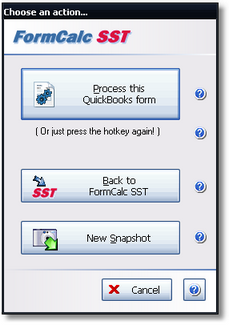
3.Process the form by either (1) pressing the hotkey a second time, or (2) clicking on the Process the QuickBooks form button.
| Here's a view of the Invoice after processing, showing the total calculated by FormCalc SST. |

How to Subtotal Columns
The simplest way to subtotal columns on QuickBooks forms is to use the same trigger Item name in several places on the form. Let's prove this by making minor changes to the Item name and FormCalc SST setup, then processing an Invoice.
| You can also calculate subtotals using different Item names. That approach may be necessary when additional calculations are needed on the subtotal rows, and those calculations need to be different for each Item. This is a more advanced approach: the rows included in each subtotal may have to be controlled by using IF() functions in the formulas. |
Changing the Item name
The Total Item we set up earlier would work for subtotals too, as is. But having the word "Total" appear on several rows of an Invoice might be confusing to someone else looking at the Invoice. So let's change the Item name to Subtotal:
1.Open the Item list by choosing Lists > Item list from the QuickBooks main menu.
2.Select the Total item by clicking on it.
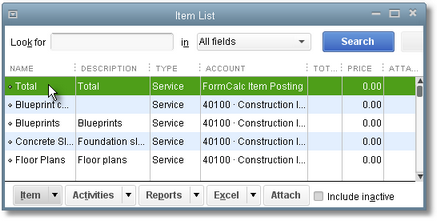
3.Choose Edit Item from the Item button's menu at the bottom of the Item list window.
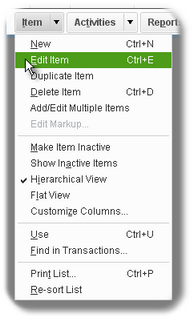
| The Edit Item window will open. |
4.Change the Item's Name and Description from Total to Subtotal:
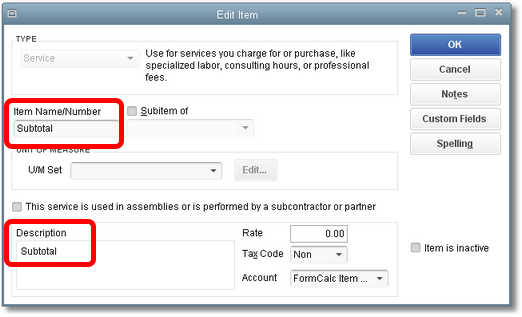
5.Click OK to close the window.
Updating the FormCalc SST file
We have not changed the layout of the QuickBooks Invoice, so we don't need to take a new snapshot. We only need to update the Item-triggered formulas 1 row with the Item's new name, Subtotal.

| Everything else stays the same. We don't need to change the formula, because of how FormCalc SST handles repeat occurrences of trigger Items. During form processing, each time an Item name appears FormCalc SST checks to see if there was a prior occurrence of it. If so, the formula is adjusted to include only data rows since the most recent prior occurrence of the Item name. |
Processing QuickBooks forms...with subtotals
The steps for processing forms is the same as describe above. We've added more data rows to the example Invoice, to better demonstrate how subtotals work.
Before processing:
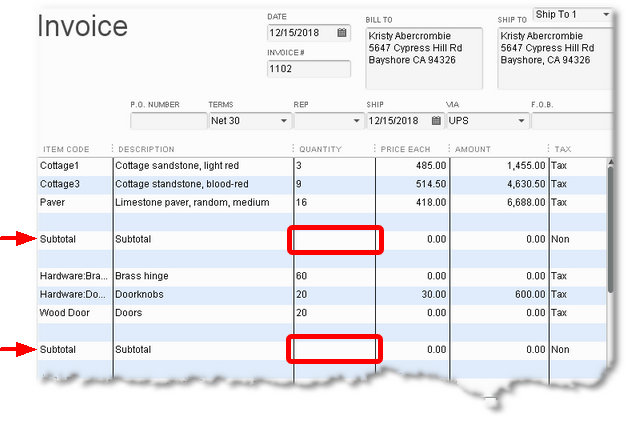
After processing with FormCalc SST (note the subtotals):
